The Industrial Revolution: Historiography and Impact
VerifiedAdded on 2020/03/04
|9
|2562
|766
AI Summary
This assignment delves into the history of how historians have understood the Industrial Revolution, examining shifting perspectives and influential theories. It explores key aspects of the revolution's impact, including agricultural advancements, class structures, international trade, colonial markets, and technological innovations. The essay draws on various historical sources and economic models to provide a comprehensive analysis of this transformative period.
Contribute Materials
Your contribution can guide someone’s learning journey. Share your
documents today.
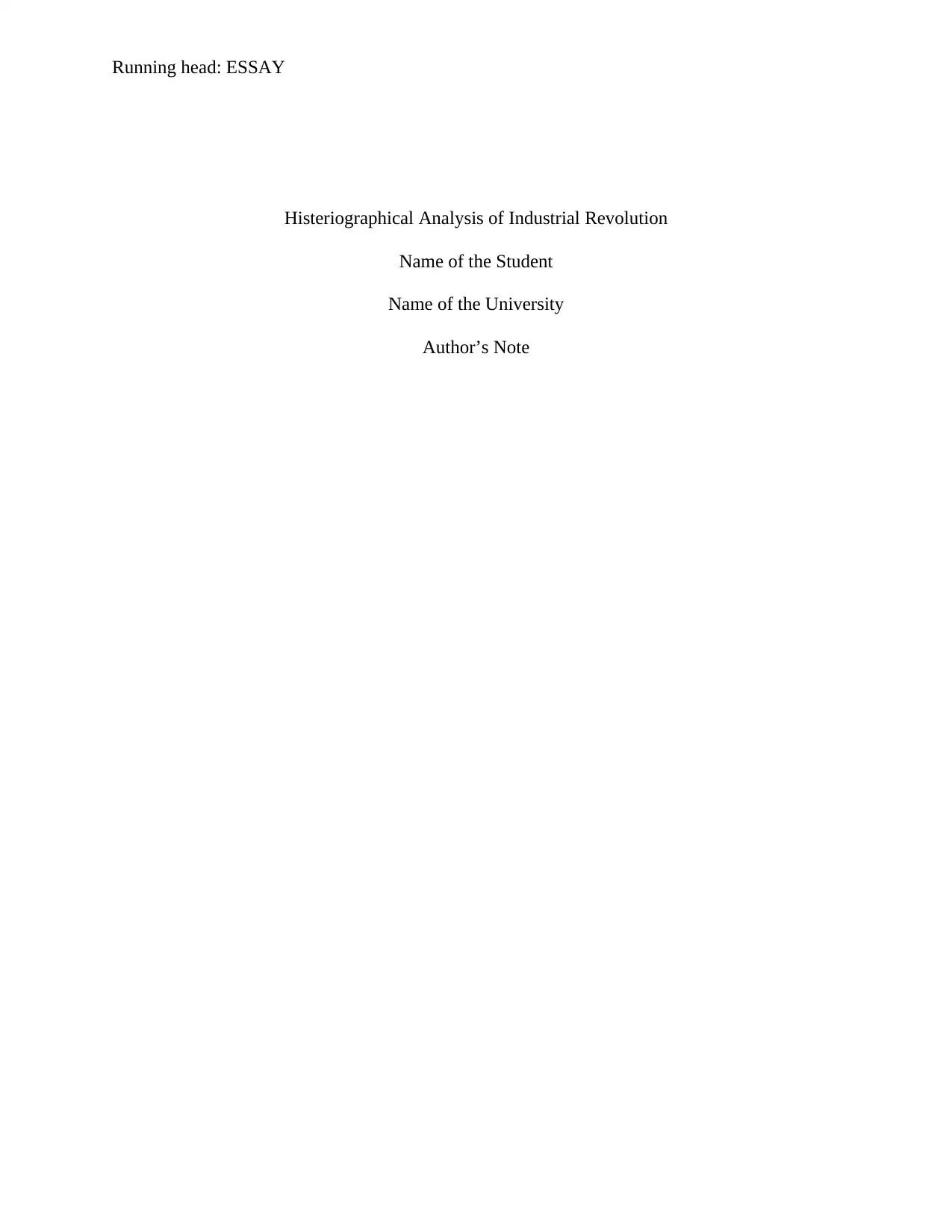
Running head: ESSAY
Histeriographical Analysis of Industrial Revolution
Name of the Student
Name of the University
Author’s Note
Histeriographical Analysis of Industrial Revolution
Name of the Student
Name of the University
Author’s Note
Secure Best Marks with AI Grader
Need help grading? Try our AI Grader for instant feedback on your assignments.
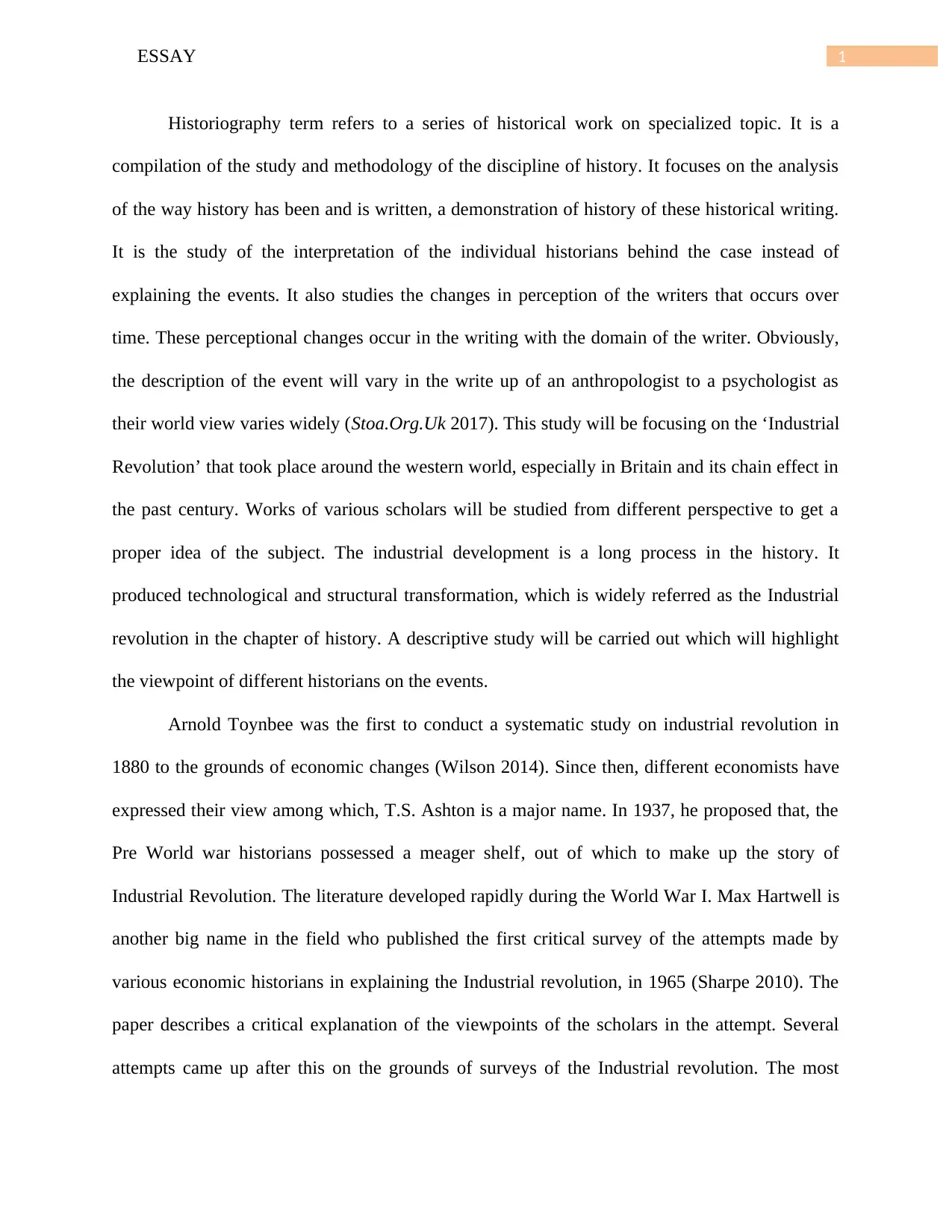
1ESSAY
Historiography term refers to a series of historical work on specialized topic. It is a
compilation of the study and methodology of the discipline of history. It focuses on the analysis
of the way history has been and is written, a demonstration of history of these historical writing.
It is the study of the interpretation of the individual historians behind the case instead of
explaining the events. It also studies the changes in perception of the writers that occurs over
time. These perceptional changes occur in the writing with the domain of the writer. Obviously,
the description of the event will vary in the write up of an anthropologist to a psychologist as
their world view varies widely (Stoa.Org.Uk 2017). This study will be focusing on the ‘Industrial
Revolution’ that took place around the western world, especially in Britain and its chain effect in
the past century. Works of various scholars will be studied from different perspective to get a
proper idea of the subject. The industrial development is a long process in the history. It
produced technological and structural transformation, which is widely referred as the Industrial
revolution in the chapter of history. A descriptive study will be carried out which will highlight
the viewpoint of different historians on the events.
Arnold Toynbee was the first to conduct a systematic study on industrial revolution in
1880 to the grounds of economic changes (Wilson 2014). Since then, different economists have
expressed their view among which, T.S. Ashton is a major name. In 1937, he proposed that, the
Pre World war historians possessed a meager shelf, out of which to make up the story of
Industrial Revolution. The literature developed rapidly during the World War I. Max Hartwell is
another big name in the field who published the first critical survey of the attempts made by
various economic historians in explaining the Industrial revolution, in 1965 (Sharpe 2010). The
paper describes a critical explanation of the viewpoints of the scholars in the attempt. Several
attempts came up after this on the grounds of surveys of the Industrial revolution. The most
Historiography term refers to a series of historical work on specialized topic. It is a
compilation of the study and methodology of the discipline of history. It focuses on the analysis
of the way history has been and is written, a demonstration of history of these historical writing.
It is the study of the interpretation of the individual historians behind the case instead of
explaining the events. It also studies the changes in perception of the writers that occurs over
time. These perceptional changes occur in the writing with the domain of the writer. Obviously,
the description of the event will vary in the write up of an anthropologist to a psychologist as
their world view varies widely (Stoa.Org.Uk 2017). This study will be focusing on the ‘Industrial
Revolution’ that took place around the western world, especially in Britain and its chain effect in
the past century. Works of various scholars will be studied from different perspective to get a
proper idea of the subject. The industrial development is a long process in the history. It
produced technological and structural transformation, which is widely referred as the Industrial
revolution in the chapter of history. A descriptive study will be carried out which will highlight
the viewpoint of different historians on the events.
Arnold Toynbee was the first to conduct a systematic study on industrial revolution in
1880 to the grounds of economic changes (Wilson 2014). Since then, different economists have
expressed their view among which, T.S. Ashton is a major name. In 1937, he proposed that, the
Pre World war historians possessed a meager shelf, out of which to make up the story of
Industrial Revolution. The literature developed rapidly during the World War I. Max Hartwell is
another big name in the field who published the first critical survey of the attempts made by
various economic historians in explaining the Industrial revolution, in 1965 (Sharpe 2010). The
paper describes a critical explanation of the viewpoints of the scholars in the attempt. Several
attempts came up after this on the grounds of surveys of the Industrial revolution. The most
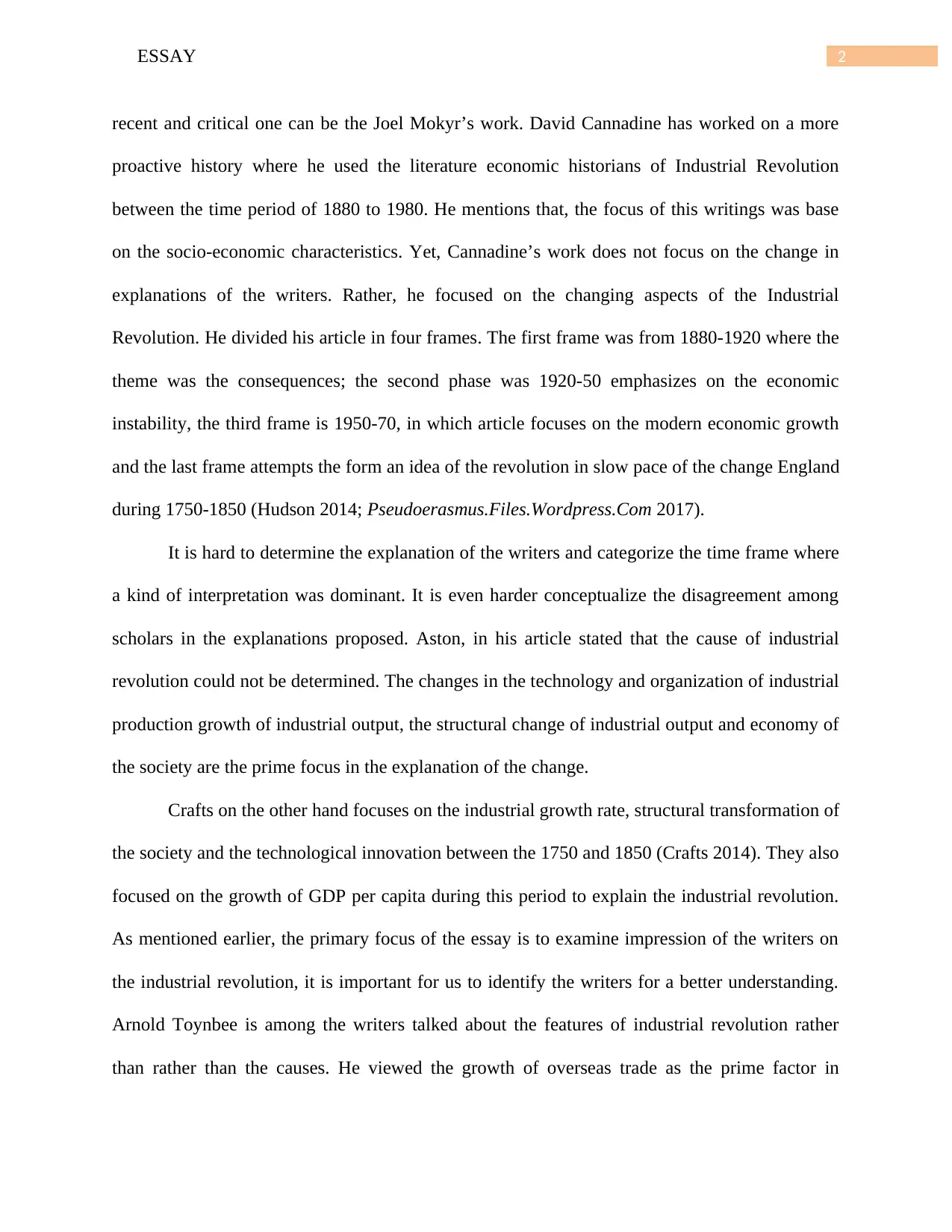
2ESSAY
recent and critical one can be the Joel Mokyr’s work. David Cannadine has worked on a more
proactive history where he used the literature economic historians of Industrial Revolution
between the time period of 1880 to 1980. He mentions that, the focus of this writings was base
on the socio-economic characteristics. Yet, Cannadine’s work does not focus on the change in
explanations of the writers. Rather, he focused on the changing aspects of the Industrial
Revolution. He divided his article in four frames. The first frame was from 1880-1920 where the
theme was the consequences; the second phase was 1920-50 emphasizes on the economic
instability, the third frame is 1950-70, in which article focuses on the modern economic growth
and the last frame attempts the form an idea of the revolution in slow pace of the change England
during 1750-1850 (Hudson 2014; Pseudoerasmus.Files.Wordpress.Com 2017).
It is hard to determine the explanation of the writers and categorize the time frame where
a kind of interpretation was dominant. It is even harder conceptualize the disagreement among
scholars in the explanations proposed. Aston, in his article stated that the cause of industrial
revolution could not be determined. The changes in the technology and organization of industrial
production growth of industrial output, the structural change of industrial output and economy of
the society are the prime focus in the explanation of the change.
Crafts on the other hand focuses on the industrial growth rate, structural transformation of
the society and the technological innovation between the 1750 and 1850 (Crafts 2014). They also
focused on the growth of GDP per capita during this period to explain the industrial revolution.
As mentioned earlier, the primary focus of the essay is to examine impression of the writers on
the industrial revolution, it is important for us to identify the writers for a better understanding.
Arnold Toynbee is among the writers talked about the features of industrial revolution rather
than rather than the causes. He viewed the growth of overseas trade as the prime factor in
recent and critical one can be the Joel Mokyr’s work. David Cannadine has worked on a more
proactive history where he used the literature economic historians of Industrial Revolution
between the time period of 1880 to 1980. He mentions that, the focus of this writings was base
on the socio-economic characteristics. Yet, Cannadine’s work does not focus on the change in
explanations of the writers. Rather, he focused on the changing aspects of the Industrial
Revolution. He divided his article in four frames. The first frame was from 1880-1920 where the
theme was the consequences; the second phase was 1920-50 emphasizes on the economic
instability, the third frame is 1950-70, in which article focuses on the modern economic growth
and the last frame attempts the form an idea of the revolution in slow pace of the change England
during 1750-1850 (Hudson 2014; Pseudoerasmus.Files.Wordpress.Com 2017).
It is hard to determine the explanation of the writers and categorize the time frame where
a kind of interpretation was dominant. It is even harder conceptualize the disagreement among
scholars in the explanations proposed. Aston, in his article stated that the cause of industrial
revolution could not be determined. The changes in the technology and organization of industrial
production growth of industrial output, the structural change of industrial output and economy of
the society are the prime focus in the explanation of the change.
Crafts on the other hand focuses on the industrial growth rate, structural transformation of
the society and the technological innovation between the 1750 and 1850 (Crafts 2014). They also
focused on the growth of GDP per capita during this period to explain the industrial revolution.
As mentioned earlier, the primary focus of the essay is to examine impression of the writers on
the industrial revolution, it is important for us to identify the writers for a better understanding.
Arnold Toynbee is among the writers talked about the features of industrial revolution rather
than rather than the causes. He viewed the growth of overseas trade as the prime factor in
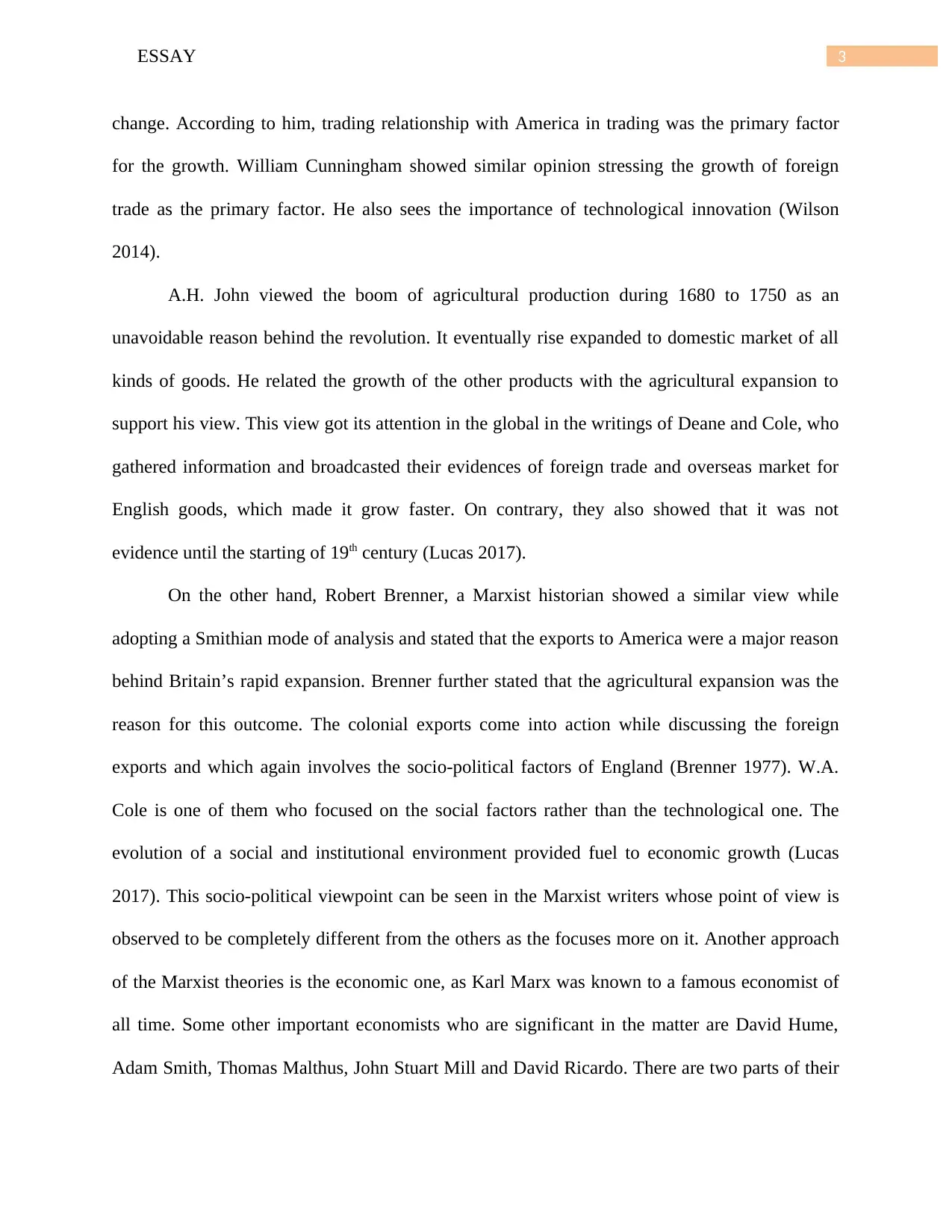
3ESSAY
change. According to him, trading relationship with America in trading was the primary factor
for the growth. William Cunningham showed similar opinion stressing the growth of foreign
trade as the primary factor. He also sees the importance of technological innovation (Wilson
2014).
A.H. John viewed the boom of agricultural production during 1680 to 1750 as an
unavoidable reason behind the revolution. It eventually rise expanded to domestic market of all
kinds of goods. He related the growth of the other products with the agricultural expansion to
support his view. This view got its attention in the global in the writings of Deane and Cole, who
gathered information and broadcasted their evidences of foreign trade and overseas market for
English goods, which made it grow faster. On contrary, they also showed that it was not
evidence until the starting of 19th century (Lucas 2017).
On the other hand, Robert Brenner, a Marxist historian showed a similar view while
adopting a Smithian mode of analysis and stated that the exports to America were a major reason
behind Britain’s rapid expansion. Brenner further stated that the agricultural expansion was the
reason for this outcome. The colonial exports come into action while discussing the foreign
exports and which again involves the socio-political factors of England (Brenner 1977). W.A.
Cole is one of them who focused on the social factors rather than the technological one. The
evolution of a social and institutional environment provided fuel to economic growth (Lucas
2017). This socio-political viewpoint can be seen in the Marxist writers whose point of view is
observed to be completely different from the others as the focuses more on it. Another approach
of the Marxist theories is the economic one, as Karl Marx was known to a famous economist of
all time. Some other important economists who are significant in the matter are David Hume,
Adam Smith, Thomas Malthus, John Stuart Mill and David Ricardo. There are two parts of their
change. According to him, trading relationship with America in trading was the primary factor
for the growth. William Cunningham showed similar opinion stressing the growth of foreign
trade as the primary factor. He also sees the importance of technological innovation (Wilson
2014).
A.H. John viewed the boom of agricultural production during 1680 to 1750 as an
unavoidable reason behind the revolution. It eventually rise expanded to domestic market of all
kinds of goods. He related the growth of the other products with the agricultural expansion to
support his view. This view got its attention in the global in the writings of Deane and Cole, who
gathered information and broadcasted their evidences of foreign trade and overseas market for
English goods, which made it grow faster. On contrary, they also showed that it was not
evidence until the starting of 19th century (Lucas 2017).
On the other hand, Robert Brenner, a Marxist historian showed a similar view while
adopting a Smithian mode of analysis and stated that the exports to America were a major reason
behind Britain’s rapid expansion. Brenner further stated that the agricultural expansion was the
reason for this outcome. The colonial exports come into action while discussing the foreign
exports and which again involves the socio-political factors of England (Brenner 1977). W.A.
Cole is one of them who focused on the social factors rather than the technological one. The
evolution of a social and institutional environment provided fuel to economic growth (Lucas
2017). This socio-political viewpoint can be seen in the Marxist writers whose point of view is
observed to be completely different from the others as the focuses more on it. Another approach
of the Marxist theories is the economic one, as Karl Marx was known to a famous economist of
all time. Some other important economists who are significant in the matter are David Hume,
Adam Smith, Thomas Malthus, John Stuart Mill and David Ricardo. There are two parts of their
Secure Best Marks with AI Grader
Need help grading? Try our AI Grader for instant feedback on your assignments.
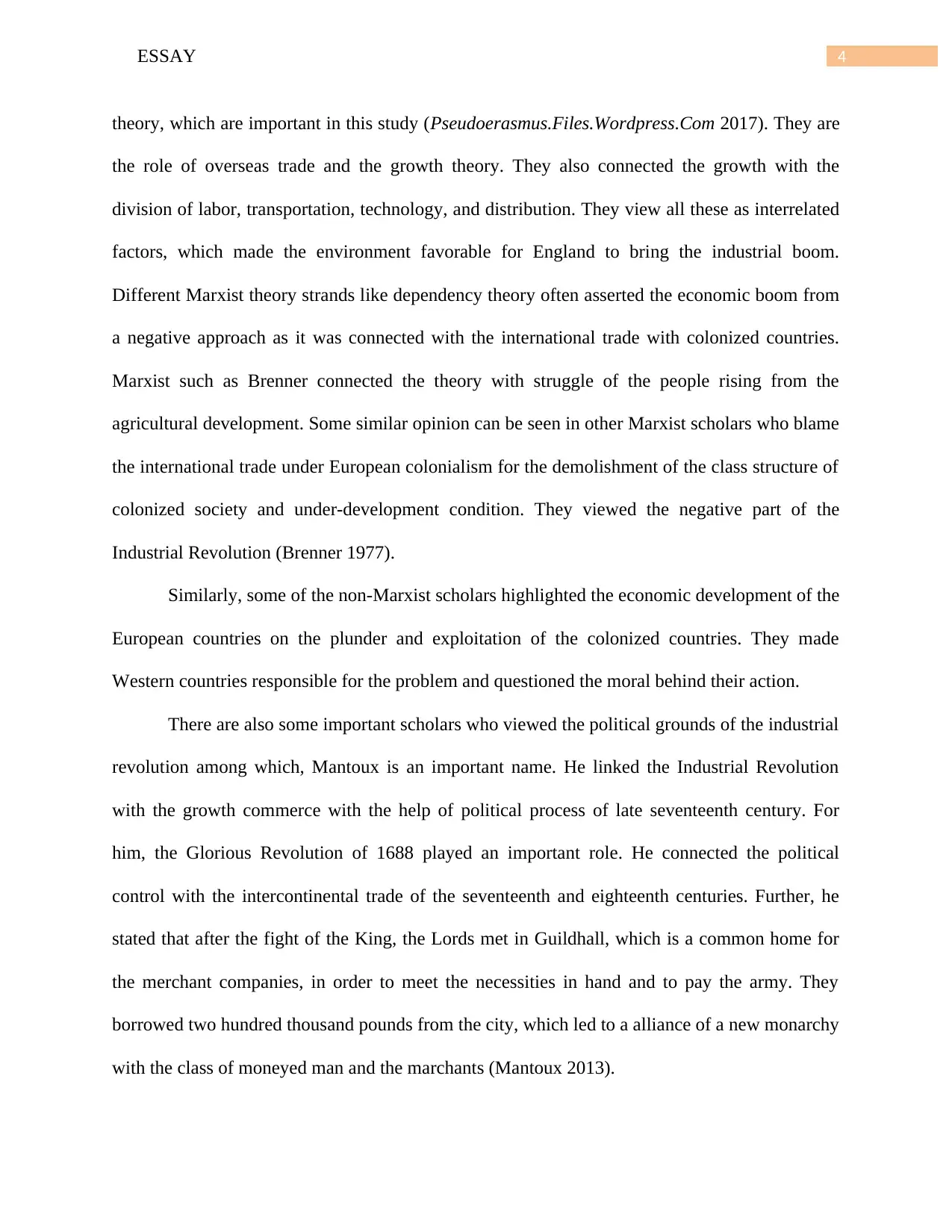
4ESSAY
theory, which are important in this study (Pseudoerasmus.Files.Wordpress.Com 2017). They are
the role of overseas trade and the growth theory. They also connected the growth with the
division of labor, transportation, technology, and distribution. They view all these as interrelated
factors, which made the environment favorable for England to bring the industrial boom.
Different Marxist theory strands like dependency theory often asserted the economic boom from
a negative approach as it was connected with the international trade with colonized countries.
Marxist such as Brenner connected the theory with struggle of the people rising from the
agricultural development. Some similar opinion can be seen in other Marxist scholars who blame
the international trade under European colonialism for the demolishment of the class structure of
colonized society and under-development condition. They viewed the negative part of the
Industrial Revolution (Brenner 1977).
Similarly, some of the non-Marxist scholars highlighted the economic development of the
European countries on the plunder and exploitation of the colonized countries. They made
Western countries responsible for the problem and questioned the moral behind their action.
There are also some important scholars who viewed the political grounds of the industrial
revolution among which, Mantoux is an important name. He linked the Industrial Revolution
with the growth commerce with the help of political process of late seventeenth century. For
him, the Glorious Revolution of 1688 played an important role. He connected the political
control with the intercontinental trade of the seventeenth and eighteenth centuries. Further, he
stated that after the fight of the King, the Lords met in Guildhall, which is a common home for
the merchant companies, in order to meet the necessities in hand and to pay the army. They
borrowed two hundred thousand pounds from the city, which led to a alliance of a new monarchy
with the class of moneyed man and the marchants (Mantoux 2013).
theory, which are important in this study (Pseudoerasmus.Files.Wordpress.Com 2017). They are
the role of overseas trade and the growth theory. They also connected the growth with the
division of labor, transportation, technology, and distribution. They view all these as interrelated
factors, which made the environment favorable for England to bring the industrial boom.
Different Marxist theory strands like dependency theory often asserted the economic boom from
a negative approach as it was connected with the international trade with colonized countries.
Marxist such as Brenner connected the theory with struggle of the people rising from the
agricultural development. Some similar opinion can be seen in other Marxist scholars who blame
the international trade under European colonialism for the demolishment of the class structure of
colonized society and under-development condition. They viewed the negative part of the
Industrial Revolution (Brenner 1977).
Similarly, some of the non-Marxist scholars highlighted the economic development of the
European countries on the plunder and exploitation of the colonized countries. They made
Western countries responsible for the problem and questioned the moral behind their action.
There are also some important scholars who viewed the political grounds of the industrial
revolution among which, Mantoux is an important name. He linked the Industrial Revolution
with the growth commerce with the help of political process of late seventeenth century. For
him, the Glorious Revolution of 1688 played an important role. He connected the political
control with the intercontinental trade of the seventeenth and eighteenth centuries. Further, he
stated that after the fight of the King, the Lords met in Guildhall, which is a common home for
the merchant companies, in order to meet the necessities in hand and to pay the army. They
borrowed two hundred thousand pounds from the city, which led to a alliance of a new monarchy
with the class of moneyed man and the marchants (Mantoux 2013).
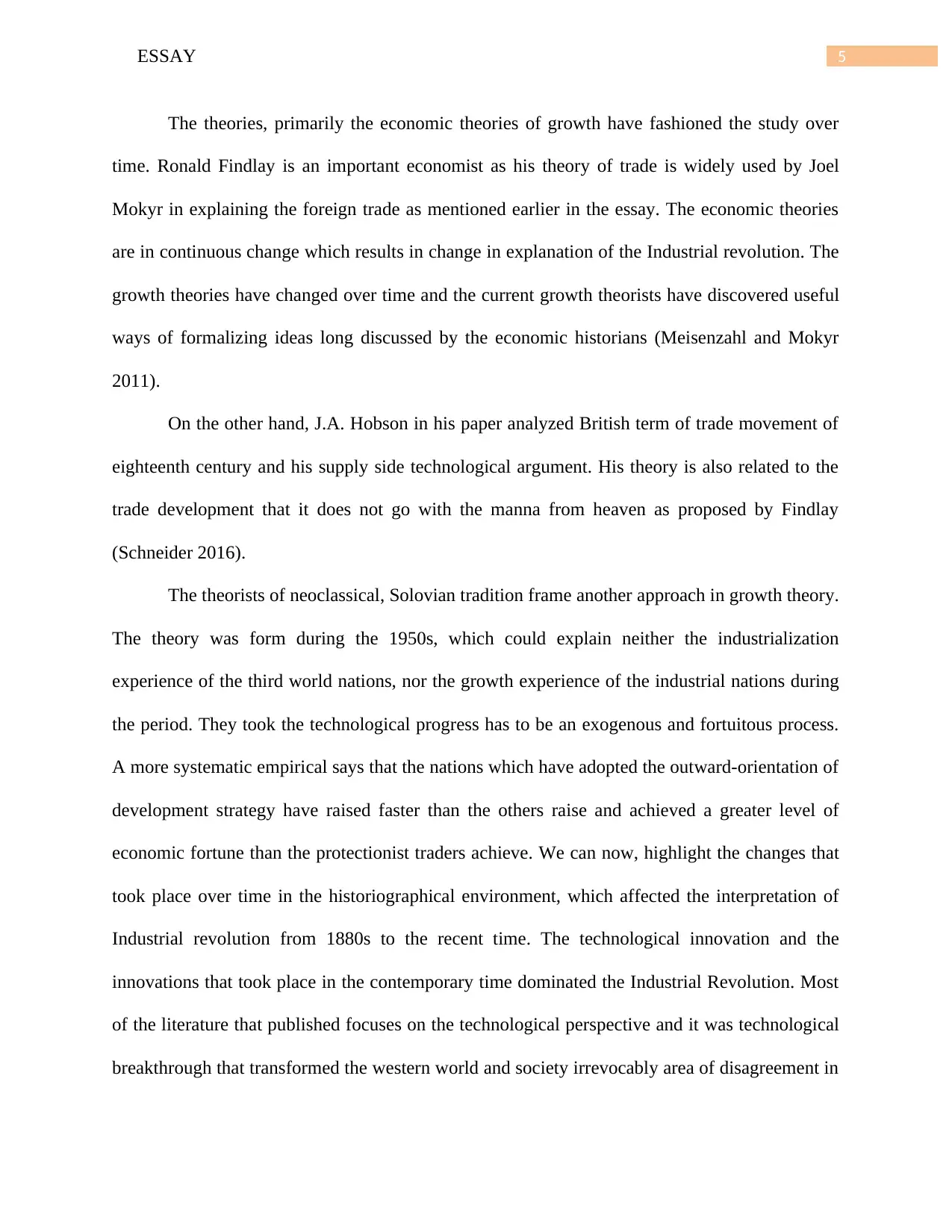
5ESSAY
The theories, primarily the economic theories of growth have fashioned the study over
time. Ronald Findlay is an important economist as his theory of trade is widely used by Joel
Mokyr in explaining the foreign trade as mentioned earlier in the essay. The economic theories
are in continuous change which results in change in explanation of the Industrial revolution. The
growth theories have changed over time and the current growth theorists have discovered useful
ways of formalizing ideas long discussed by the economic historians (Meisenzahl and Mokyr
2011).
On the other hand, J.A. Hobson in his paper analyzed British term of trade movement of
eighteenth century and his supply side technological argument. His theory is also related to the
trade development that it does not go with the manna from heaven as proposed by Findlay
(Schneider 2016).
The theorists of neoclassical, Solovian tradition frame another approach in growth theory.
The theory was form during the 1950s, which could explain neither the industrialization
experience of the third world nations, nor the growth experience of the industrial nations during
the period. They took the technological progress has to be an exogenous and fortuitous process.
A more systematic empirical says that the nations which have adopted the outward-orientation of
development strategy have raised faster than the others raise and achieved a greater level of
economic fortune than the protectionist traders achieve. We can now, highlight the changes that
took place over time in the historiographical environment, which affected the interpretation of
Industrial revolution from 1880s to the recent time. The technological innovation and the
innovations that took place in the contemporary time dominated the Industrial Revolution. Most
of the literature that published focuses on the technological perspective and it was technological
breakthrough that transformed the western world and society irrevocably area of disagreement in
The theories, primarily the economic theories of growth have fashioned the study over
time. Ronald Findlay is an important economist as his theory of trade is widely used by Joel
Mokyr in explaining the foreign trade as mentioned earlier in the essay. The economic theories
are in continuous change which results in change in explanation of the Industrial revolution. The
growth theories have changed over time and the current growth theorists have discovered useful
ways of formalizing ideas long discussed by the economic historians (Meisenzahl and Mokyr
2011).
On the other hand, J.A. Hobson in his paper analyzed British term of trade movement of
eighteenth century and his supply side technological argument. His theory is also related to the
trade development that it does not go with the manna from heaven as proposed by Findlay
(Schneider 2016).
The theorists of neoclassical, Solovian tradition frame another approach in growth theory.
The theory was form during the 1950s, which could explain neither the industrialization
experience of the third world nations, nor the growth experience of the industrial nations during
the period. They took the technological progress has to be an exogenous and fortuitous process.
A more systematic empirical says that the nations which have adopted the outward-orientation of
development strategy have raised faster than the others raise and achieved a greater level of
economic fortune than the protectionist traders achieve. We can now, highlight the changes that
took place over time in the historiographical environment, which affected the interpretation of
Industrial revolution from 1880s to the recent time. The technological innovation and the
innovations that took place in the contemporary time dominated the Industrial Revolution. Most
of the literature that published focuses on the technological perspective and it was technological
breakthrough that transformed the western world and society irrevocably area of disagreement in
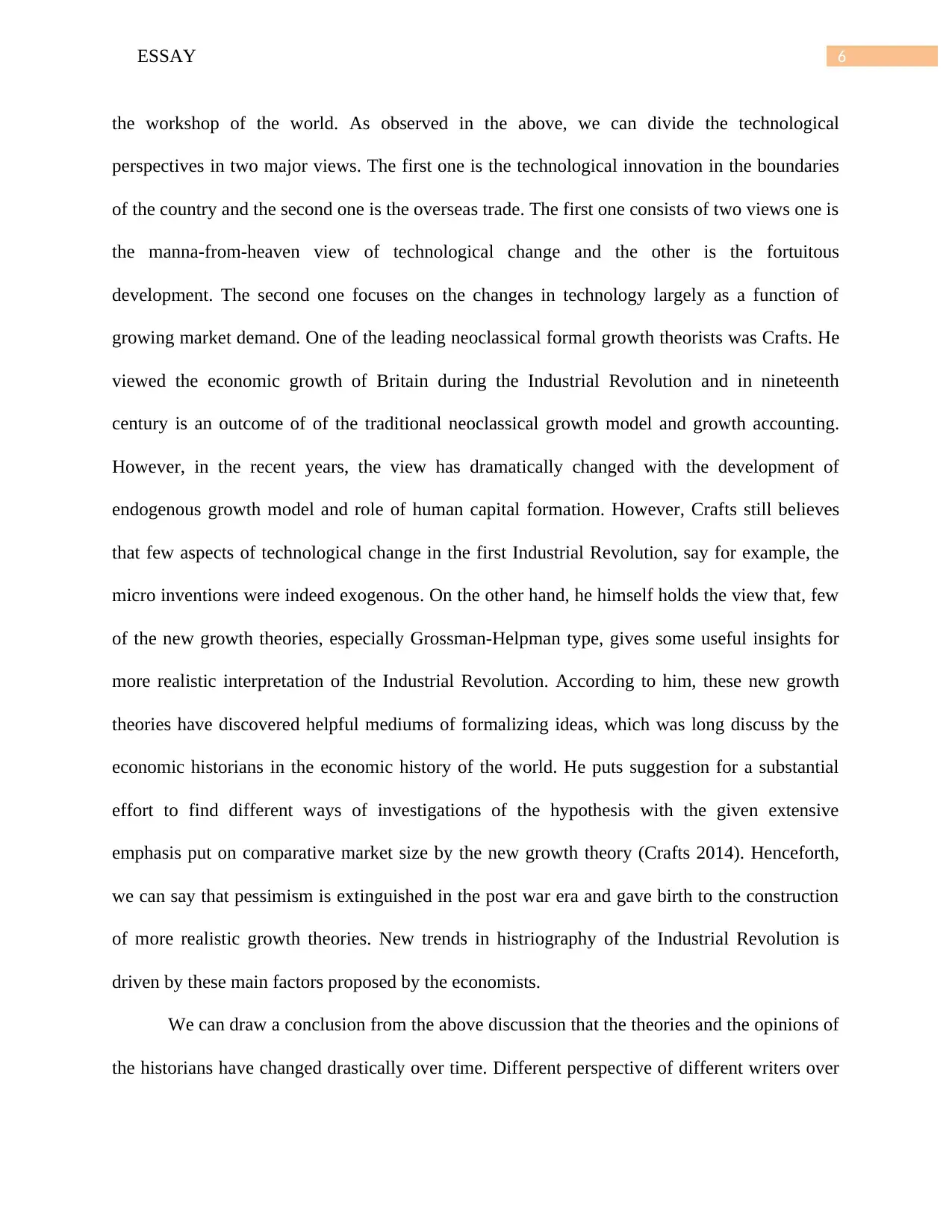
6ESSAY
the workshop of the world. As observed in the above, we can divide the technological
perspectives in two major views. The first one is the technological innovation in the boundaries
of the country and the second one is the overseas trade. The first one consists of two views one is
the manna-from-heaven view of technological change and the other is the fortuitous
development. The second one focuses on the changes in technology largely as a function of
growing market demand. One of the leading neoclassical formal growth theorists was Crafts. He
viewed the economic growth of Britain during the Industrial Revolution and in nineteenth
century is an outcome of of the traditional neoclassical growth model and growth accounting.
However, in the recent years, the view has dramatically changed with the development of
endogenous growth model and role of human capital formation. However, Crafts still believes
that few aspects of technological change in the first Industrial Revolution, say for example, the
micro inventions were indeed exogenous. On the other hand, he himself holds the view that, few
of the new growth theories, especially Grossman-Helpman type, gives some useful insights for
more realistic interpretation of the Industrial Revolution. According to him, these new growth
theories have discovered helpful mediums of formalizing ideas, which was long discuss by the
economic historians in the economic history of the world. He puts suggestion for a substantial
effort to find different ways of investigations of the hypothesis with the given extensive
emphasis put on comparative market size by the new growth theory (Crafts 2014). Henceforth,
we can say that pessimism is extinguished in the post war era and gave birth to the construction
of more realistic growth theories. New trends in histriography of the Industrial Revolution is
driven by these main factors proposed by the economists.
We can draw a conclusion from the above discussion that the theories and the opinions of
the historians have changed drastically over time. Different perspective of different writers over
the workshop of the world. As observed in the above, we can divide the technological
perspectives in two major views. The first one is the technological innovation in the boundaries
of the country and the second one is the overseas trade. The first one consists of two views one is
the manna-from-heaven view of technological change and the other is the fortuitous
development. The second one focuses on the changes in technology largely as a function of
growing market demand. One of the leading neoclassical formal growth theorists was Crafts. He
viewed the economic growth of Britain during the Industrial Revolution and in nineteenth
century is an outcome of of the traditional neoclassical growth model and growth accounting.
However, in the recent years, the view has dramatically changed with the development of
endogenous growth model and role of human capital formation. However, Crafts still believes
that few aspects of technological change in the first Industrial Revolution, say for example, the
micro inventions were indeed exogenous. On the other hand, he himself holds the view that, few
of the new growth theories, especially Grossman-Helpman type, gives some useful insights for
more realistic interpretation of the Industrial Revolution. According to him, these new growth
theories have discovered helpful mediums of formalizing ideas, which was long discuss by the
economic historians in the economic history of the world. He puts suggestion for a substantial
effort to find different ways of investigations of the hypothesis with the given extensive
emphasis put on comparative market size by the new growth theory (Crafts 2014). Henceforth,
we can say that pessimism is extinguished in the post war era and gave birth to the construction
of more realistic growth theories. New trends in histriography of the Industrial Revolution is
driven by these main factors proposed by the economists.
We can draw a conclusion from the above discussion that the theories and the opinions of
the historians have changed drastically over time. Different perspective of different writers over
Paraphrase This Document
Need a fresh take? Get an instant paraphrase of this document with our AI Paraphraser
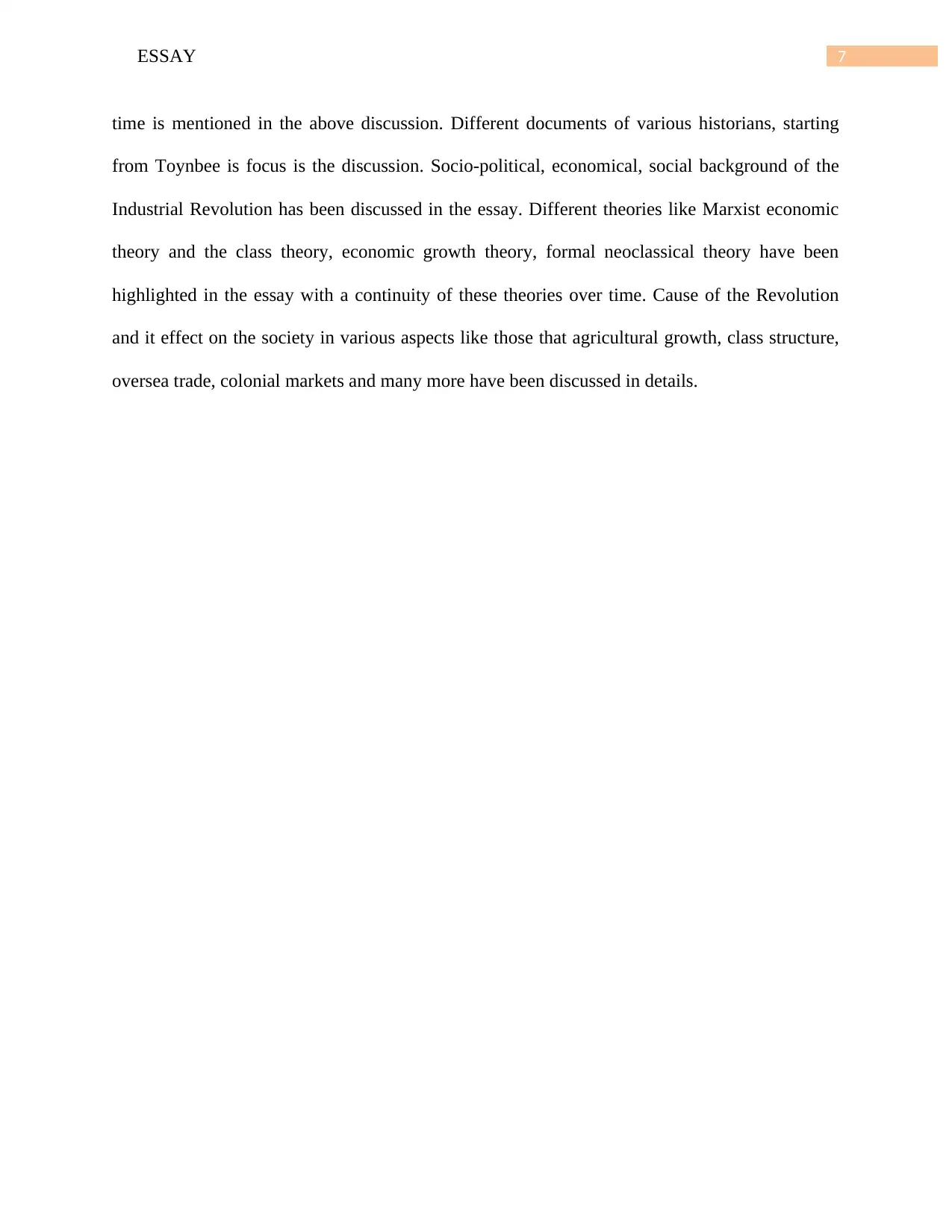
7ESSAY
time is mentioned in the above discussion. Different documents of various historians, starting
from Toynbee is focus is the discussion. Socio-political, economical, social background of the
Industrial Revolution has been discussed in the essay. Different theories like Marxist economic
theory and the class theory, economic growth theory, formal neoclassical theory have been
highlighted in the essay with a continuity of these theories over time. Cause of the Revolution
and it effect on the society in various aspects like those that agricultural growth, class structure,
oversea trade, colonial markets and many more have been discussed in details.
time is mentioned in the above discussion. Different documents of various historians, starting
from Toynbee is focus is the discussion. Socio-political, economical, social background of the
Industrial Revolution has been discussed in the essay. Different theories like Marxist economic
theory and the class theory, economic growth theory, formal neoclassical theory have been
highlighted in the essay with a continuity of these theories over time. Cause of the Revolution
and it effect on the society in various aspects like those that agricultural growth, class structure,
oversea trade, colonial markets and many more have been discussed in details.
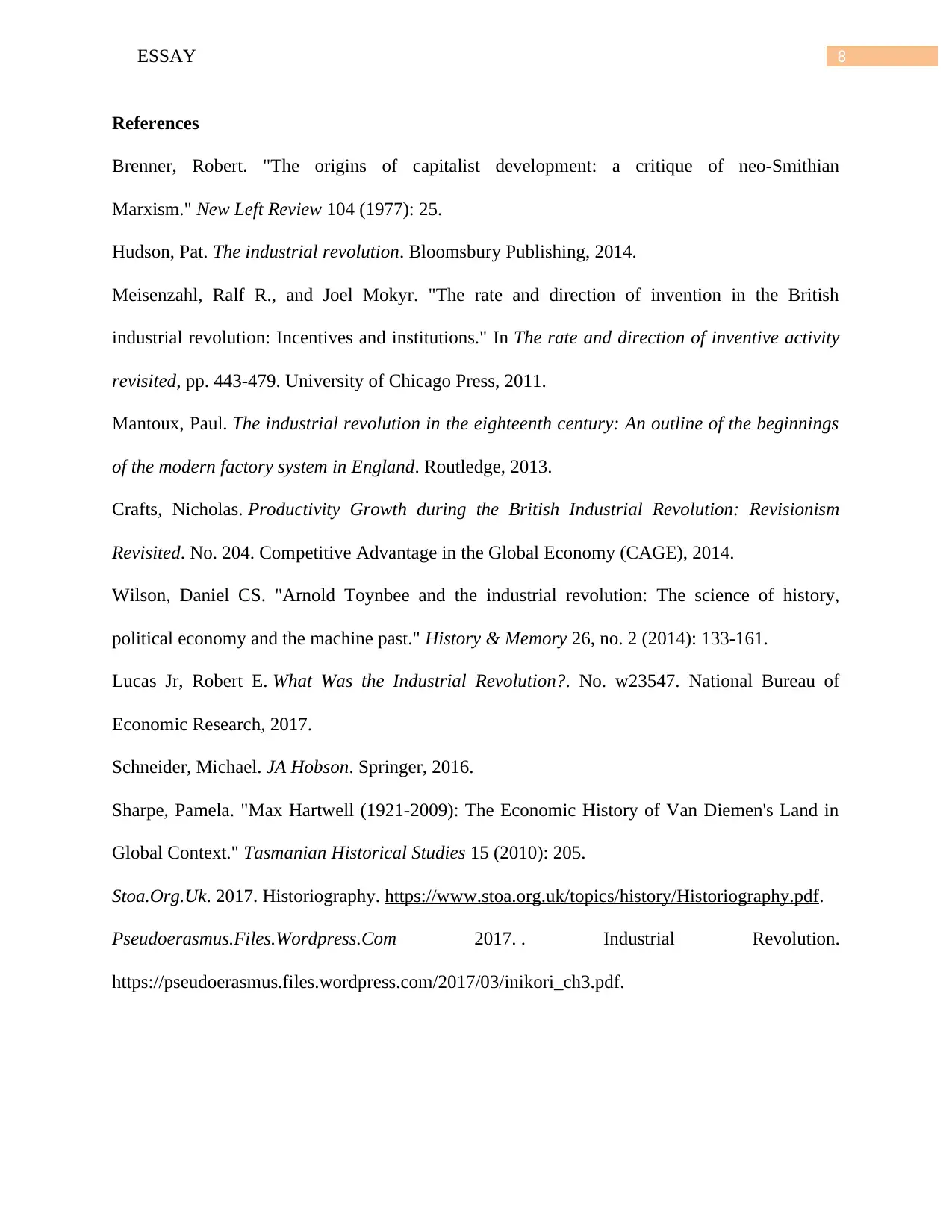
8ESSAY
References
Brenner, Robert. "The origins of capitalist development: a critique of neo-Smithian
Marxism." New Left Review 104 (1977): 25.
Hudson, Pat. The industrial revolution. Bloomsbury Publishing, 2014.
Meisenzahl, Ralf R., and Joel Mokyr. "The rate and direction of invention in the British
industrial revolution: Incentives and institutions." In The rate and direction of inventive activity
revisited, pp. 443-479. University of Chicago Press, 2011.
Mantoux, Paul. The industrial revolution in the eighteenth century: An outline of the beginnings
of the modern factory system in England. Routledge, 2013.
Crafts, Nicholas. Productivity Growth during the British Industrial Revolution: Revisionism
Revisited. No. 204. Competitive Advantage in the Global Economy (CAGE), 2014.
Wilson, Daniel CS. "Arnold Toynbee and the industrial revolution: The science of history,
political economy and the machine past." History & Memory 26, no. 2 (2014): 133-161.
Lucas Jr, Robert E. What Was the Industrial Revolution?. No. w23547. National Bureau of
Economic Research, 2017.
Schneider, Michael. JA Hobson. Springer, 2016.
Sharpe, Pamela. "Max Hartwell (1921-2009): The Economic History of Van Diemen's Land in
Global Context." Tasmanian Historical Studies 15 (2010): 205.
Stoa.Org.Uk. 2017. Historiography. https://www.stoa.org.uk/topics/history/Historiography.pdf.
Pseudoerasmus.Files.Wordpress.Com 2017. . Industrial Revolution.
https://pseudoerasmus.files.wordpress.com/2017/03/inikori_ch3.pdf.
References
Brenner, Robert. "The origins of capitalist development: a critique of neo-Smithian
Marxism." New Left Review 104 (1977): 25.
Hudson, Pat. The industrial revolution. Bloomsbury Publishing, 2014.
Meisenzahl, Ralf R., and Joel Mokyr. "The rate and direction of invention in the British
industrial revolution: Incentives and institutions." In The rate and direction of inventive activity
revisited, pp. 443-479. University of Chicago Press, 2011.
Mantoux, Paul. The industrial revolution in the eighteenth century: An outline of the beginnings
of the modern factory system in England. Routledge, 2013.
Crafts, Nicholas. Productivity Growth during the British Industrial Revolution: Revisionism
Revisited. No. 204. Competitive Advantage in the Global Economy (CAGE), 2014.
Wilson, Daniel CS. "Arnold Toynbee and the industrial revolution: The science of history,
political economy and the machine past." History & Memory 26, no. 2 (2014): 133-161.
Lucas Jr, Robert E. What Was the Industrial Revolution?. No. w23547. National Bureau of
Economic Research, 2017.
Schneider, Michael. JA Hobson. Springer, 2016.
Sharpe, Pamela. "Max Hartwell (1921-2009): The Economic History of Van Diemen's Land in
Global Context." Tasmanian Historical Studies 15 (2010): 205.
Stoa.Org.Uk. 2017. Historiography. https://www.stoa.org.uk/topics/history/Historiography.pdf.
Pseudoerasmus.Files.Wordpress.Com 2017. . Industrial Revolution.
https://pseudoerasmus.files.wordpress.com/2017/03/inikori_ch3.pdf.
1 out of 9
Your All-in-One AI-Powered Toolkit for Academic Success.
+13062052269
info@desklib.com
Available 24*7 on WhatsApp / Email
![[object Object]](/_next/static/media/star-bottom.7253800d.svg)
Unlock your academic potential
© 2024 | Zucol Services PVT LTD | All rights reserved.


